Have you ever looked at yourself in the mirror or in a photo and wished your smile was a little bit…brighter? If so, you’re hardly alone. There is a vast array of teeth whitening treatments available in the US — from state-of-the-art laser treatment to home whitening kits.
In this teeth whitening guide, we’ll talk about the various teeth whitening dentistry procedures in the US, so you can give yourself a smile makeover.
We’ll cover a full range of professional and DIY solutions, how much they cost, and how effective they are, so you can make an informed choice when comparing the best teeth whitening treatment options.
If you’re short on time and looking for at-home whitening solutions, here are our best teeth whitening recommendations:
| Snow | Smile Brilliant | ALIGNERCO |
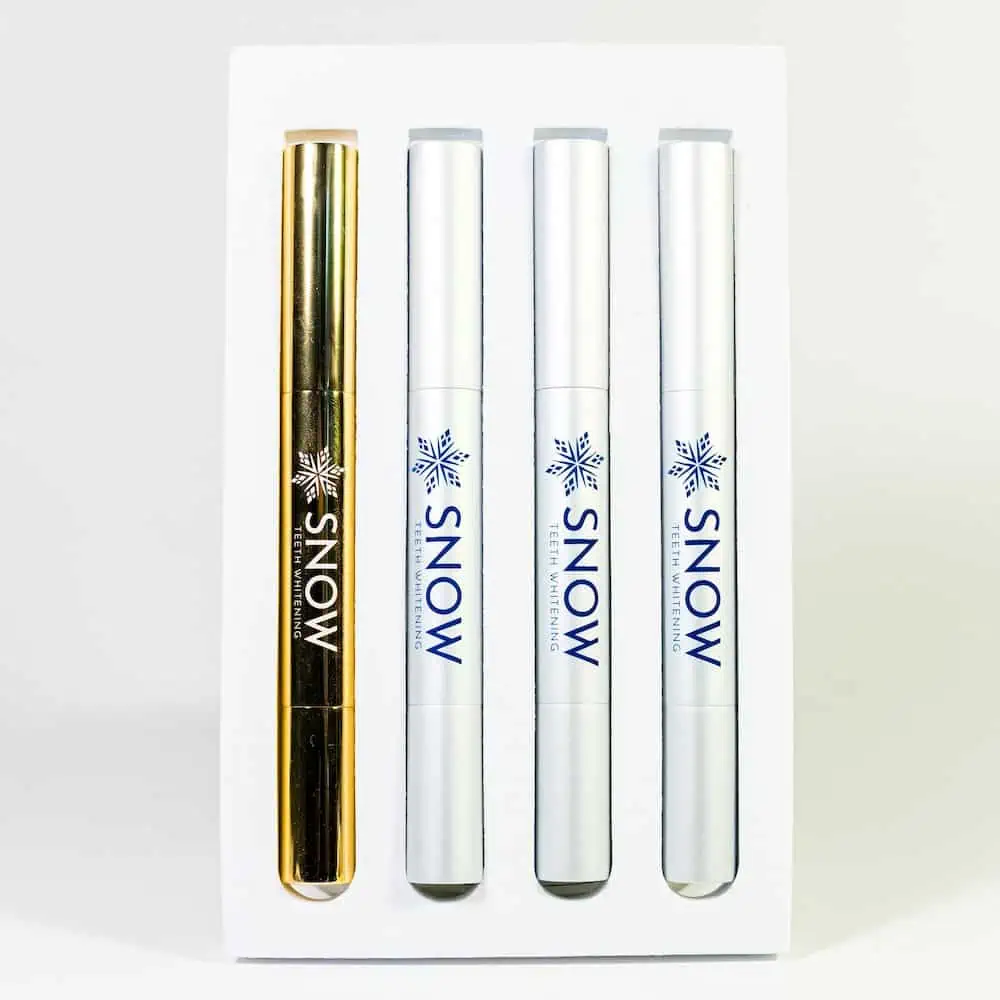  | 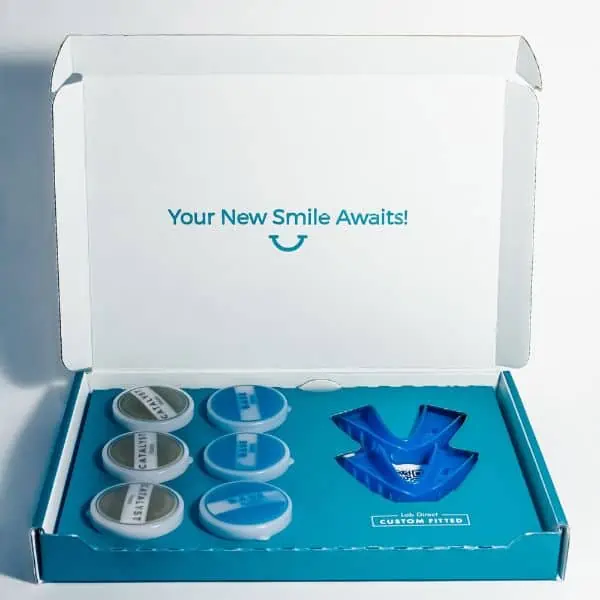  | 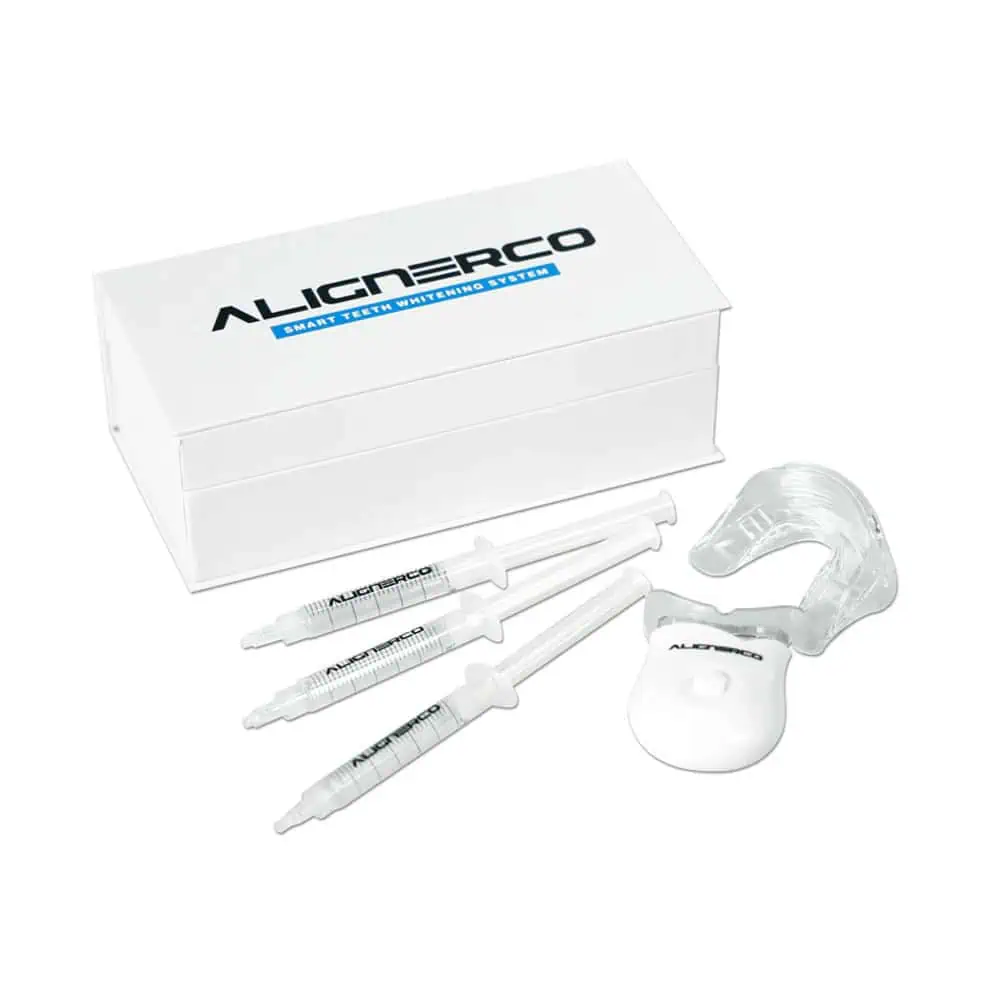  |
|
|
|
Teeth whitening options
There are many tried and tested ways to whiten teeth these days or get rid of white spots on teeth, including:
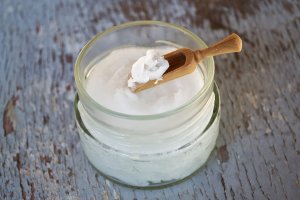

- Gels
- Strips
- Trays
- Bleach
- Lasers
- Toothpaste
- Mouthwash
- Coconut oil
Confused? Don’t worry, all will become clear.
The best teeth whitening method for you will depend first on what type of staining you are dealing with — whether it is intrinsic or extrinsic, on the surface or in the enamel.
It will also depend on how much you have to spend, how quickly you want to see results, how permanent you want it to be, and how much discomfort you’re willing to go through.
Note that all the whitening techniques we cover here will only work on your natural teeth; any dentures, fillings, veneers, or implants will remain the same color.
Whitening is often part of a Hollywood dental makeover to completely restore your smile.
Best teeth whitening options in the US
Teeth whitening at the dentist
Before we dive into our teeth whitening guide, it’s important to note that the duration of whitening results will vary from patient to patient.
Results are always patient-specific and are strongly influenced by which whitening method is used, as well as dietary and environmental factors. The effects of whitening procedures typically last from just weeks to 6 to 12 months.


If you have the money to spend, it’s a good idea to visit your dentist to talk about cosmetic teeth whitening. Not only are their treatments effective, but they also know how to carry them out safely and can help if you have any side effects.
It’s also a good idea to begin with an evaluation from a dental professional so they can let you know if your teeth are healthy enough for teeth whitening.
Whitening also may be part of a larger smile design process, which you can read about here.
There are three main types of whitening treatment available at the dentist. Below you’ll find some information about each option, but you can view our article about professional teeth whitening for greater detail.
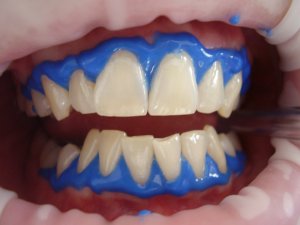

Laser teeth whitening options
Laser bleaching uses lasers to speed up the bleaching effect of a concentrated gel applied to the teeth. Although it’s the most expensive method, it’s also the closest you’ll get to “instant” teeth whitening.
Your dentist will first apply a rubber seal to protect your gums, then will cover your teeth with a bleaching product – probably containing hydrogen peroxide for teeth whitening. By shining a laser on your teeth, whitening happens much faster than with other treatments.
This intense whitening treatment should give clear results after just one visit, but it also has greater potential for sensitivity following treatment.
Zoom teeth whitening
Using technology from Philips, Zoom whitening works in a similar way to laser whitening but instead uses LED lights to accelerate a whitening agent.
LED teeth whitening systems are less intense, meaning less chance of sensitivity but also a longer treatment time (normally 3-4 sessions of 45-60 minutes).
This can be followed by a course of home teeth whitening treatment to prolong the results.
Professional bleaching teeth whitening options
A relatively cheap teeth whitening method offered by dentists uses custom trays to apply professional tooth whitening gel. This gel is usually stronger than the ones provided in DIY kits, so it can produce better results.
Your dentist will take impressions of your teeth which are used to create custom mouth trays. Once these are ready, you complete your whitening treatment at home.
Some professional whitening gels can be left on overnight – handy if you don’t have time to wear your trays during the day. You’ll need to ask your dentist about the options they offer, though.
Teeth whitening kits and other home solutions
More affordable teeth whitening solutions don’t involve a visit to the dentist – you do everything yourself at home. This table shows an overview of the different options, but keep reading to find out more about each one.
| Product | LED whitening | Bleaching trays | Teeth whitening strips | Whitening pens | Whitening toothpaste |
| Approximate cost | $100–$400 | $7–$75 | $8–$40 | $5–$24 | $2.50–$20 |
| Treatment time | 10–30 days, 9–30 minute sessions | 10-14 days, 5-20 minutes per day | 1-2 weeks, 10-60 minutes per application | 1-2 weeks, 10-30 minutes per application | 5-6 minutes every day (normal brushing time) |
| Results appear in… | After first or second use | 4–10 days | 1–2 weeks | 1–2 weeks | Results may appear over prolonged use |
| Comments | Touchups recommended every once in a while, good for people with teeth sensitivity | Available over-the-counter, may cause sensitivity | Available peroxide-free, may cause sensitivity | Cheap option for quick results, may cause sensitivity | Only removes surface stains |
LED whitening
Blue teeth whitening light kits are another option if you want a treatment you can do in your own time at home.
These usually consist of a whitening gel or serum that you apply to your teeth or put directly in a tray that goes into your mouth. Then, a blue LED light is used to activate the bleaching agent. With some versions, you can immerse the trays in boiling water and then bite down on them to mold them to the shape of your teeth. Others use fixed-shape trays to apply the gel.
One criticism of this kind of kit is that the gel can easily leak out and damage your gums and cause sensitivity, and it doesn’t always give even coverage over your teeth.
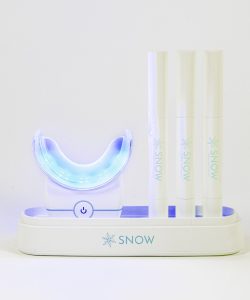

Snow Teeth Whitening kits also address sensitivity with their market-leading technology that lets you ‘paint’ the whitening serum directly onto your teeth before inserting your LED mouthpiece.
The mouthpiece plugs into your smartphone or any other USB port, so you can use it anywhere, and they also have a premium wireless kit that you can even use in the shower—super convenient!
Snow’s whitening system works in as little as 9 minutes a day, but you can wear it for as many as 30 minutes per session, twice a day, to speed results along. Their gel formula is made so that people with sensitive teeth can use it too, but their desensitizing serum will help in more serious cases.
Snow’s whitening kits come with a 30-day money-back guarantee if you’re not satisfied with your results. Read our full review of Snow and the Snow teeth whitening wireless kit review to find out more.
Most of these kits use hydrogen peroxide or carbamide peroxide as the main whitening ingredient, and while for many people, that isn’t a problem, some may find that peroxide whitening is just too harsh.
ALIGNERCO is known for perfecting peoples’ smiles with their affordable at-home aligner system, and now you can also get the best price on teeth whitening.
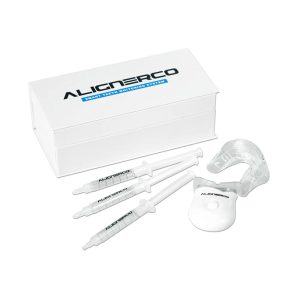

This kit comes with a whitening gel that you insert into the custom-fit mouthpiece and an LED light, which can help speed up the tooth whitening process.
See your teeth 5 shades whiter in just 5 days. Plus, get the best price at just $24.99! The full contents of the kit are:
- 3 whitening gel pens
- 1 LED light
- 1 shade guide
- Custom-fit mouth tray
- 1 user manual
Bleaching trays with gel
If you’re looking for a cheaper option for LED kits, you’ll find a wide array of over-the-counter kits that use a bleaching gel.
These kits may be cheaper, but the results are usually not as good nor as long-lasting, and the ingredients are often harsher.
Our in-depth article on teeth whitening kits has a lot more information on the types of kits and different brands available. Take a look if you want to compare a wider range of products.
Keep in mind that with any of these non-professional bleaching gel kits, there is a greater risk of the bleaching gel leaking out and burning or blistering other parts of your mouth. It’s also harder to get even coverage of the gel if your mouthpiece isn’t tight. Snow (mentioned above) is one example of a kit that addresses these problems with its technology.
Some people whiten their teeth with bleaching gel, using their Invisalign aligners to hold the gel. You can read more about whitening teeth with Invisalign in our guide here.
Teeth whitening strips
Whitening strips are available over the counter or online. Strips are placed directly onto teeth, so they are much cleaner and easier to use than gels and trays.
Many brands have the appeal of being peroxide-free, but some still rely on peroxide to whiten teeth. Strips usually need to be applied for around 30 minutes and then removed, but it’s also possible to buy strips that require shorter wear times.
You can learn more about this at-home whitening method in our white strips article. Learn more about other popular brands, and in particular, read our reviews about Crest Whitestrips and Snow Magic Strips.
Teeth whitening pens
Whitening pens are really more like brushes; they consist of a small tube of gel that is applied directly to teeth via a built-in brush.
Pens usually contain hydrogen peroxide or carbamide peroxide, although some peroxide-free brands are available. Users like them because they’re so convenient; you can carry them anywhere and use them whenever you have time.
Treatment takes from 1-2 weeks, with about 2 applications per day lasting anywhere between 5 and 30 minutes, depending on the manufacturer.
Whitening toothpaste
Perhaps you’ve seen a whitening version of your favorite toothpaste at the supermarket and thought, “It can’t hurt to try”. Well, the thing is, it can hurt. Literally. Using an abrasive product like this scratches your tooth enamel. When used over a long period of time (e.g. to brush teeth every day), many users experience increased sensitivity.
Whitening toothpaste only removes surface stains – rather than altering the color of the teeth themselves – so if your teeth are naturally yellowish, using whitening toothpaste won’t change that. However, it can be used to prolong the effects of other whitening treatments.
It’s also the cheapest option around, which makes it a popular option for giving your smile a slight boost. Certain toothbrushes (both manual and electric toothbrushes) are also designed to achieve better stain removal. Read more about the Snow LED toothbrush.
Sensodyne, Oral B, Crest, and Colgate all offer a widely available range of toothpastes formulated specifically to whiten teeth. Other brands, like Smileactives, offer a gel that is added to your toothpaste.
You can read our full guide to the best whitening toothpastes for more detailed information.
Ways to whiten teeth naturally
If you’re happy to trade quick results for a more natural approach, there are several natural teeth whitening solutions that some people swear by. While these won’t give you a dazzling white smile overnight, some people attest that they are effective at keeping teeth clean and white over the longer term.
However, these natural remedies for whitening should be used with caution, as products like activated charcoal and fruit can be abrasive to the tooth’s enamel, potentially increasing the susceptibility to tooth decay.
- Coconut oil pulling (swishing a spoonful around your mouth for 10-15 minutes) is a traditional Indian technique for improving oral hygiene. You’ll need to rinse and brush as usual afterward, but you should notice that your teeth feel cleaner.
- A homemade whitening paste can be concocted using baking soda mixed with water or a very small amount of hydrogen peroxide. Get a runny consistency and then rub onto teeth for 30 seconds after brushing normally.
- Activated charcoal will turn your whole mouth black, but once you wash it off, you’ll find your teeth are sparkly clean. Available as a powder or toothpaste – read more about this below.
- Mashed strawberries can be applied directly to the teeth and left for a few minutes – a technique championed by model Tyra Banks. Be sure to rinse well afterwards.
- Apple cider vinegar can be effective at removing dark stains on teeth. Rub it on your teeth for about a minute using your finger, then rinse with water and brush normally. Continue for at least a month to get good results.
Here is a video explaining more about the increasingly popular oral health treatment of coconut oil pulling:
Whitening sensitive teeth
Some patients report experiencing “unbearable” pain after whitening their teeth. If you have sensitive teeth or have experienced sensitivity in the past, it’s a good idea to speak to your dentist about your concerns. They may be able to administer topical pain relief to manage any pain you experience after whitening.
If you opt for a home whitening treatment, it might be a good idea to build up to the manufacturer’s recommended treatment time. For example, if they tell you to apply a gel for 15 minutes, try it for five minutes first and see how your teeth feel.
Products that don’t contain hydrogen peroxide may result in less sensitivity but can also be less effective. Potassium nitrate and fluoride are effective pain relievers, so look for products that contain those.
Find out more about sensitive teeth after whitening.
How much does teeth whitening cost?
The cost of teeth whitening at the dentist can be from $300 to $1,800, depending on if you’re getting professional bleaching or laser whitening treatment, which is the most expensive option.
You can expect to pay much less for teeth whitening at home, with prices ranging anywhere from $20 for a kit bought from Amazon, to $300 for an LED whitening kit.
Some US insurance companies do make some allowance for this treatment. If you have a dental plan, it’s worth checking to see whether it offers any benefits for whitening. A dentist near you may also offer a dental savings plan to help pay for treatment.
Of course, before enrolling in a plan, make sure it covers the teeth whitening procedures you want. Find out more in our full guide to cosmetic dental insurance.
How long does teeth whitening last?
The length of time that teeth whitening results last varies with each individual and depends on various factors. These factors include the type of whitening treatment, diet, and lifestyle habits.
Whitening treatments are meant to get rid of the stains you have, but it’s up to you to prevent future stains. Here are a few tips you can keep in mind after you’ve had a whitening treatment to keep your teeth whiter for longer:
- Avoid foods that stain: Avoid stain offenders like coffee, tea, red wine, and colas
- Brush after eating: Stop stains from setting in by brushing them off right away (unless you eat something acidic, then refrain from brushing until 30 minutes have passed so you don’t harm enamel)
- Eat calcium-rich foods: Think of dairy products like cheese and milk
- Don’t smoke: Smoking is a sure way to turn your teeth a lovely shade of brown
Is teeth whitening safe?
The safest way to whiten teeth is through an approved dentist. Dental professionals are trained to carry out various whitening procedures and also to identify cases where whitening isn’t recommended. For example, people with gum disease or dental crowns are advised not to whiten their teeth—these also don’t whiten like natural teeth.
Side effects of teeth whitening
- Sensitivity: Many people experience sensitivity after a tooth whitening treatment, but your dentist can recommend products to alleviate the effects
- Gum irritation: Gums can become irritated if they come into contact with the whitening product
- Multicolor teeth: This happens if you get whitening done, but you have a tooth restoration, like a crown or a denture — the restoration isn’t whitened, and so stays the same color while the rest of your teeth change hue
Is teeth whitening safe for teenagers?
Tooth whitening is not recommended for children 15 years old and under. If a child under 15 is struggling with self-esteem issues due to severe discoloration, then the process should be monitored by a dental professional. You can read more about tooth whitening for adolescents in this study by the American Academy of Pediatric Dentistry.
Other safety considerations
You may see whitening advertised by local beauty salons or mobile whitening services, but these are not trained dental professionals.
Home whitening kits can be a great solution for many people as well; just make sure to choose one that gets good reviews and can demonstrate proven results.
If you’re concerned about the risks of whitening your teeth, it’s best to speak to your dentist first. You can also talk to people you know who have had similar treatment and ask about their experience.
For more about whitening, read 6 teeth whitening myths you should know about.
Causes of discolored teeth
Natural discoloration
Have you thought about why you don’t have white teeth in the first place? Actually, our teeth are not supposed to be bright white. Although the enamel that coats teeth is a blueish-white color, its translucency means the yellow color of the dentin below can show through.
Enamel thins as we get older, so it’s normal for teeth to darken or become yellower over time. You can read more about why teeth go yellow and what to do about it in our full article on the topic.
Intrinsic staining
Intrinsic stains can come from many sources, including medication like antibiotics or prescription mouthwashes. They can also come from trauma, certain genetic conditions, or acquired conditions like fluorosis.
Extrinsic staining
Extrinsic staining happens over time and is caused by environmental factors typically related to diet, oral hygiene habits, or bad habits like smoking and drinking.
In the next section, we’ll take a closer look at the foods that can stain your teeth — these fall into the category of extrinsic staining.
Foods that stain teeth
For most people, the yellowing process is accelerated by the things we eat and drink and other external factors. These include:
- Berries: Although the antioxidants in berries provide health benefits, their deep hue can cause staining (have you ever tried to get a raspberry stain out of a white shirt?).
- Sauces: Brightly colored sauces like curries and tomato sauce can also contribute to staining, and the acidity of tomatoes makes them a double culprit. Opt for a lighter, creamy version to lessen the chances of tooth staining.
- Coffee: The dark color and acidity of coffee both have a detrimental effect on your teeth.
- Tea: Black tea, in particular, can be more damaging than coffee. Even lighter herbal teas can erode enamel and cause staining.
- Wine: The tannins in red wine are responsible for turning teeth into a shade of grey. White wine, meanwhile, although not directly responsible for staining, can make existing stains darker.
- Sugary drinks: It’s well known that sugary soft drinks cause tooth decay, but because they do this by wearing away that bright tooth enamel, your teeth will appear darker over time, too.
- Smoking: The nicotine and tar in tobacco can stain teeth very quickly. Over the years, heavy smokers may find their teeth turning brown, known as smokers’ teeth.
- Braces: While adult braces help improve your smile by making your teeth straighter, at the same time, they can leave them looking less-than-white.
- Some antibiotics: Tetracycline teeth are from taking this antibiotic as a child, resulting in grey stripes.


You might say that the best way to whiten teeth, then, is just to avoid the things that are likely to stain them. But we know it’s not always that simple, so while you sip that coffee, we’ll continue explaining how to undo the damage later.
Minimize the staining effects of certain foods by eating them alongside foods that can prevent tooth staining, such as cheese, lettuce, celery, carrots, apples, and cauliflower. These either help clean teeth through friction or work to neutralize the acid that damages enamel.
No matter how hard you try to maintain a white smile, there may still come a time when you consider whitening.
Tooth discoloration can be caused by a number of lifestyle factors, which can change the efficacy of most tooth whitening procedures.
For most people, teeth stains are caused by a lifetime of consuming stain-prone food and drinks like coffee and tea. In addition, other stain-causing habits like smoking and chewing tobacco are also common culprits, as are certain prescription medications.
For others, it’s not a matter of bad habits but a combination of age and genetics, or medications or fluoride treatment that causes white spots on teeth. Teeth whitening treatments can help brighten your smile by several shades. However, going back to these stain-causing habits could affect how long your results last.
Dr. Brandon Murri, Family and Cosmetic Dentistry of the Rockies
A brief history of tooth whitening
The question of how to whiten teeth is one that has bothered people for thousands of years.
In ancient Egypt, having white teeth was a sign of wealth. Egyptians used a paste made from ground pumice stone and wine vinegar, applied with a frayed stick (the original toothbrush). But that’s not as bad as the Romans, who used urine. It would have worked because it contains ammonia, but thankfully we’ve now found other solutions.


In the 17th century, before dentists existed in their own right, barbers would take care of oral health. This often involved pulling problem teeth, but they also whitened teeth by filing down the stained enamel and applying nitric acid. It goes without saying that you shouldn’t try this at home.
Fortunately, in the 1960s, dentists identified the whitening properties of peroxide. This was quite accidental, as they originally used hydrogen peroxide as an antiseptic treatment for gums but noticed that when teeth were exposed to it over time, they began to whiten.
It was another 20 years before commercial tooth whitening solutions emerged. Dental trays were filled with a thick whitening gel containing carbamide peroxide – a technique still widely used today. Aren’t you glad we’ve said goodbye to metal files, urine, and sticks?
Conclusion
There are many teeth whitening options to consider when you want a brighter smile. Visiting a dentist – either for in-office whitening or a take-home kit – will help ensure your treatment is conducted safely and effectively, with the supervision of a trained professional.
However, not everybody can afford professional whitening, which is why we have provided this teeth whitening guide. In this case, there are many good teeth whitening solutions available over the counter and online. They may not be quite as effective as in-office treatments, but they can still whiten teeth by several shades over one to two weeks of treatment.
Teeth whitening products in the US are heavily regulated, so there is little risk of them damaging your teeth if used as instructed. Whitening gel may be harmful if it comes into contact with gums and may cause sensitivity, which is why we recommend a system like Snow, our best overall whitening kit, with its gentle formula.
Pens, strips, and other products can be good for topping up and maintaining results but may not give much of a whitening effect when used alone.
If you have any concerns about whitening your teeth or are unsure whether it’s safe for you, we recommend you speak to a dentist first.
For more information, you can see all of our topics on teeth whitening.
FAQs
How do I find teeth whitening near me?
If a particular brand of professional teeth whitening appeals to you, check the manufacturer’s website to find a dentist offering teeth whitening services near you. Alternatively, ask your usual dentist if they offer any teeth whitening services or if they can recommend a nearby dentist who does.
How much is teeth whitening?
Professional teeth whitening can cost nearly $2,000, while at-home kits are usually around $200. White strips and toothpaste are the cheapest options, but not as effective as more intensive methods.
Does teeth whitening work?
Yes, the majority of teeth whitening products work to some degree. But it’s important to differentiate between surface stain removal, like from toothpaste or white strips, and enamel bleaching. You should also keep in mind that just because a whitening technique works, it doesn’t mean it is safe for your teeth in the long run.
What is the best way to whiten teeth quickly?
When you get in-office whitening, you’ll walk out with noticeably whiter teeth. If your budget doesn’t permit that, try a home whitening kit that can begin to whiten your teeth in a few days.
How long does teeth whitening last?
Treatments for whitening teeth can last as little as a few months or over a year. Professional teeth whitening gel and teeth whitening trays will have longer-lasting results.
How do I get white teeth?
Teeth whitening options include in-office professional whitening, at-home kits, strips, and natural home remedies. Professional whitening is the most expensive option and also the most effective. Natural remedies like coconut oil or activated charcoal will be much more affordable but not nearly as effective.
And at-home kits fall somewhere in between unless you choose a remote treatment option SNOW, which actually does offer the same whitening gel that you would get at the dentist’s office.
Does teeth whitening damage tooth enamel?
Tooth whitening procedures do not damage tooth enamel, even though you may feel some sensitivity. What can damage enamel are abrasive products like activated charcoal.
Does insurance cover teeth whitening treatments?
While insurance doesn’t cover whitening in the traditional sense, there are some plans that offer small allowances for whitening, typically in the range of $100 or $200.
These tend to be full-coverage plans that have high annual maximums, low deductibles, and higher monthly premiums.
National Center for Biotechnology Information: https://www.ncbi.nlm.nih.gov/pmc/articles/PMC4058574/ Consulted 23rd April 2019.
ADA.org: Whitening. Consulted 3rd April, 2021
AAPD: Tooth Whitening in Children and Adolescents: A Literature Review. Consulted 8th November 2022.
National Center for Biotechnology Information: https://www.ncbi.nlm.nih.gov/pmc/articles/PMC4058574/ Consulted 23rd April 2019.
ADA.org: Whitening. Consulted 3rd April, 2021
AAPD: Tooth Whitening in Children and Adolescents: A Literature Review. Consulted 8th November 2022.




